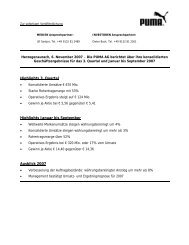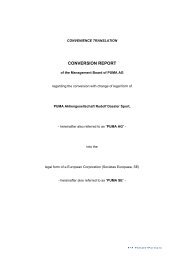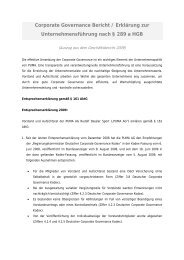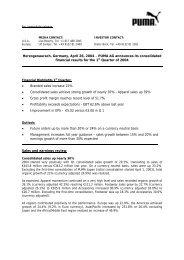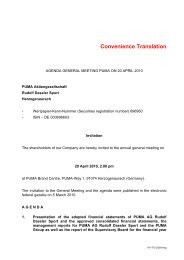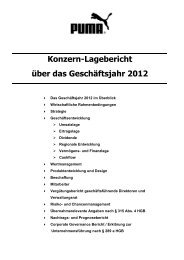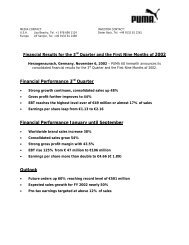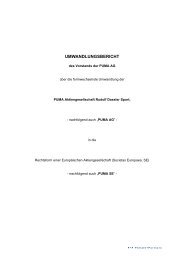PUMA.Safe Environmental Handbook Volume 1 - About PUMA
PUMA.Safe Environmental Handbook Volume 1 - About PUMA
PUMA.Safe Environmental Handbook Volume 1 - About PUMA
Create successful ePaper yourself
Turn your PDF publications into a flip-book with our unique Google optimized e-Paper software.
<strong>Environmental</strong> impact<br />
A change in the make-up, functioning, or appearance of the environment. For example, greenhouse gases (GHGs)<br />
contribute to climate change which is associated with a range of environmental impacts such as reduced crop yields,<br />
changes in water availability and increases in extreme weather. Waste disposal results in GHG emissions as well as<br />
environmental impacts from leachate which can affect water courses and local disamenity impacts caused by dust, noise<br />
and odor.<br />
By reporting the results of the E P&L we are being transparent about the extent of our environmental impacts. We<br />
believe this will provide a basis for more meaningful, evidence-based engagement with our stakeholders and enable us<br />
to demonstrate clearly the impact of our activities to reduce our impacts.<br />
Ultimately, the E P&L will enable us to make better, more informed business decisions that take account of<br />
environmental impacts as well as more traditional financial and operational considerations.<br />
Through placing a monetary value on our environmental impacts we sought answers to several important questions:<br />
• How can we help our employees, shareholders and our suppliers understand the magnitude and importance of<br />
our impacts on the environment?<br />
• How can everyone in the business grasp the significance of the amount of CO2 released, the impacts of land<br />
conversion required to provide raw materials, or the volume of water consumed and factor this into day to day<br />
decision making?<br />
• Relative to one another, which are our most significant environmental impacts?<br />
• Where in our supply chain should we focus our resources to reduce our environmental impacts?<br />
• How can we help others understand the challenge of reducing our environmental impacts, and the work we are<br />
doing to manage them?<br />
We recognize that we must account for the cost of nature in our day to day business decisions. Most people in the<br />
business and among our suppliers are not familiar with the language of sustainability and often struggle to put figures<br />
such as tones of GHG emissions and cubic meters of water into context.<br />
We chose to convert our environmental impacts into monetary terms to make them digestible and meaningful to a<br />
much wider audience. In doing so we believe we have shed light on the true scale of our impacts, and enabled simpler<br />
communication of their implications.<br />
The results of our corporate E P&L clearly show that the vast majority of environmental impacts are originating in the<br />
supply chain, and here particularly the raw material stage (please refer to the results figure below).<br />
While <strong>PUMA</strong> has also published an E P&L for selected products and aims to release a corporate level E P&L regularly<br />
going forward, the first results clearly reinforce the need to focus on the raw material stage of the supply chain. As<br />
indicated in figure 5, Tier 4 or the production of raw materials represent 57% of all calculated costs to the environment,<br />
while <strong>PUMA</strong>s own operations (including transport of products from country of manufacture to selling markets) add up to<br />
only 6% of the total environmental cost calculated.<br />
For a full report on the <strong>PUMA</strong> E P&L, please visit<br />
http://about.puma.com/sustainability/<br />
15






